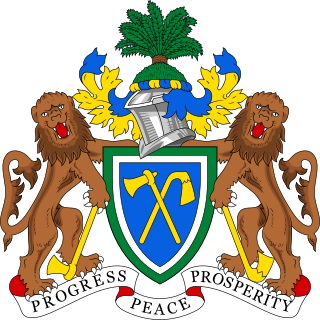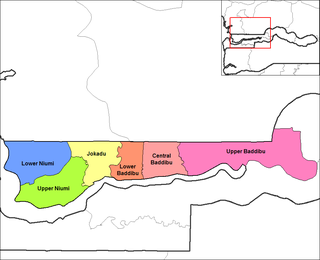
Kiang Central is one of the six districts of the Lower River Division of the Gambia. Along with Kiang East and Kiang West, it makes up the Kiang area. In the 2013 census, it had a population of 8,366. [1]

Kiang Central is one of the six districts of the Lower River Division of the Gambia. Along with Kiang East and Kiang West, it makes up the Kiang area. In the 2013 census, it had a population of 8,366. [1]

Lower River Division is one of the five administrative divisions of the Gambia. Its capital is Mansa Konko. The city and area council elections were held during April 2002, when Wally S.M. Sanneh, an APRC candidate became the Mayor, winning unopposed. The council was led by Alliance for Patriotic Reorientation and Construction (APRC), which won all the 12 seats.

Central River was the largest of the five administrative divisions of the Gambia. Its capital was Janjanbureh, on MacCarthy Island. The largest settlement was Bansang, with an estimated population in 2008 of 8,381.

North Bank was one of the five administrative divisions of the Gambia. Its capital was Kerewan. It was subsequently reorganised as the Kerewan Local Government Area (LGA), without any change in the area covered.

Upper River was one of the five Divisions of the Gambia. Its capital was Basse Santa Su. It was subsequently reorganised as the Basse Local Government Area, without any change in the area covered.

West Coast Region, originally the Western Division, also known as Foni or Fonyi, was one of the five administrative divisions of the Gambia. Its capital was Brikama. It was subsequently reorganised as the Brikama Local Government Area (LGA), without any change in the area covered.

The Gambia is subdivided into 43 districts. They are listed below by Local Government Area, each with its population at the 15 April 2013 census.
Kombo Central is one of the nine districts of the Gambia's Western Division, which is located to the south of the Gambia River in the southwest of the country. Kombo Central is in the southwest of the division, between Kombo East and Kombo South. In the 2013 census, it had a population of 142,831.
Kombo South is one of the nine districts of the Gambia's Western Division, which is located to the south of the Gambia River in the southwest of the country. Kombo South is in the southwest of the division, between Kombo Central and Kombo North/Saint Mary. In the 2013 census, it had a population of 108,773.

Lower Saloum is one of the ten districts of the Central River Division of the Gambia. Its population in the 2013 census was 15,881.

Niamina East is one of the ten districts of the Central River Division of the Gambia. Its population in the 2013 census was 24,571.

Niamina West is one of the ten districts of the Central River Division in the Gambia. In the 2013 census, it had a population of 7,293.

Nianija is one of the ten districts of the Central River Division of the Gambia. In the 2013 census, it had a population of 10,175.

Upper Saloum is one of the ten districts of the Central River Division of the Gambia. In the 2013 census, it had a population of 19,145.

Jarra Central is one of the six districts of the Lower River Division of the Gambia. In the 2013, it had a population of 8,437.

Jarra East is one of the six districts of the Lower River Division of the Gambia. In the 2013 census, it had a population of 16,551.

Jarra West is one of the six districts of the Lower River Division of the Gambia. In the 2013 census, it had a population of 27,205.

Kiang East is one of the six districts of the Lower River Division of the Gambia. Along with Kiang Central and Kiang West, it makes up the Kiang area. In the 2013 census, it had a population of 6,849.

Kiang West is one of the six districts of the Lower River Division of the Gambia. Along with Kiang Central and Kiang East, it makes up the Kiang area. In the 2013 census, it had a population of 14,953.

Central Baddibu is one of the six districts of the North Bank Division of the Gambia. In the 2013 census, it had a population of 20,104.

Upper Baddibu was one of the six districts of the North Bank Division of The Gambia. Its main town was Farafenni. The North Bank Division is now the Kerewan Local Government Area, and the former Upper Baddibu District is now divided into an Illiasa District and a Sabach Sanjal District. Its population in the 2003 census, prior to division, was 55,370.